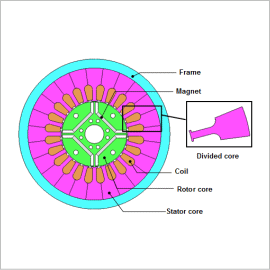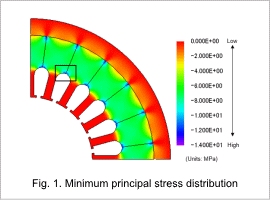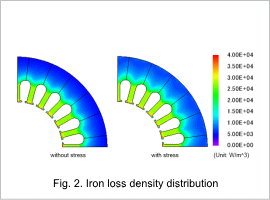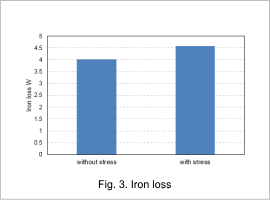*Please prepare a license ID and password for the license administrator.
*It is different from the service for JMAG WEB MEMBER (free membership). Please be careful.
Overview

Smaller size and higher output are being demanded of the motors used for applications such as air conditioning compressors. One production technique for achieving this is a higher lamination factor in divided cores. The stress caused by press-fitting a divided stator core into a frame is known to increase iron loss in a motor if magnetic steel sheet is used for the core.
Iron loss is affected by magnetic flux density and stress. Specifically, it increases in areas of high magnetic flux density with high frequency, and in areas of high stress. Further, the stress caused by press fitting has its own distribution, and is particularly large in the core and back yoke. So, in order to evaluate the iron loss with good accuracy, it is necessary to correctly obtain the magnetic flux density distribution, time variations, and stress distribution.
This Application Note presents how to use the Press Fit condition to model an analysis of the stress from fitting a core to a frame, and then obtain the iron loss density of an IPM motor under no load, with and without accounting for the stress.
Iron loss is affected by magnetic flux density and stress. Specifically, it increases in areas of high magnetic flux density with high frequency, and in areas of high stress. Further, the stress caused by press fitting has its own distribution, and is particularly large in the core and back yoke. So, in order to evaluate the iron loss with good accuracy, it is necessary to correctly obtain the magnetic flux density distribution, time variations, and stress distribution.
This Application Note presents how to use the Press Fit condition to model an analysis of the stress from fitting a core to a frame, and then obtain the iron loss density of an IPM motor under no load, with and without accounting for the stress.
Minimum Principal Stress Distribution

The minimum principal stress distribution is indicated in fig.1. Tensile stress occurs in the frame and teeth, but compressive stress that especially effects iron loss is produced largely in the contact faces between the divisions of the core. The compressive stress is especially large in the area of the model within the square in fig.1, but this is because of the slots’ geometry.
Iron Loss Density Distribution
Fig.2 shows the iron loss density distribution, and Fig.3 shows the comparison of iron loss values. The iron loss density distribution varies depending on whether or not the stress is accounted for, with iron loss increased by around 10% due to the stress. An analysis that accounts for the compressive stress caused by the press-fitting needs to be performed to evaluate the iron losses more accurately because the iron losses increase when the compressive stress is applied.




